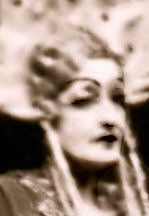
Madeleine Vhita
Vhita, Madeleine * ? (?), † ? (?).
(by Christophe Delhoume): Madeleine Vhita was one of the most important figure of Paris musical circles of the1930's, just as Jane Bathori or Claire Croiza used to be a decade before. In spite of a very limited repertoire, she enjoyed a great career as an opera singer; but was much more praised and demanded, as a recitalist or on the concert stage. Extremely good looking, elegant, with a fine contralto voice (despite a rather short top register), Madeleine Vhita was a versatile artist and a fine musician, having many connections with the composers of her time. Her repertoire at the opera, was based principally on a couple of roles: The Nurse in ARIANE ET BARBE-BLEUE, Geneviève in PELLEAS, a few Wagnerian parts, and of course, the creations she did during her career (Klytämnestra in ELEKTRA and Electre in Darius Milhaud's LES CHOEPHORES. ) Her career at the Paris Opera was rather short, due to the competition she had to face with singers like Lapeyrette, Jeanne Montfort or Georgette Caro; and included only two Wagnerian roles, Brangäne and Waltraute. With the recommendation of Philippe Gaubert, with whom she had performed many times on the concert stage, she made her debut on February 26, 1930 as Brangäne opposite Lubin as Isolde, Franz, Duclos, Huberty, and Gaubert himself at the pit. She repeated the role four times until the end of the season, as well as during the revival of March 1931 with a cast featuring Lubin, Forti, Brownlee and Pernet. Vhita went back on the roster for the last time from May 10 to 31 st , 1935 for three GÖTTERDÄMMERUNG performances where she partnered Germaine Lubin, Germaine Hoerner,De Trevi, Singher and Journet, always with Gaubert conducting. In other French Theatres, Madeleine Vhita appeared in Bordeaux , Angers where she sang the local premiere of Dukas' ARIANE ET BARBE-BLEUE in 1930 with Suzanne Balguerie, Strasbourg Opera where she created both Klytämnestra in ELEKTRA under Strauss's baton in 1932, and as the Nurse in ARIANE ET BARBE-BLEUE on the following year, both opposite Marcelle Bunlet in the title-parts. But above all, Vhita had a wide and extended concert repertoire and remained extremely busy, all along her career, with concert performances. Gaubert invited her several times from 1927, to join the Orchestre de la Société des Conservatoires, helping her to built and develop her repertoire. In April 1927, he offered Vhita her firt Nurse in ARIANE ET BARBE-BLEUE, which she repeated on March 1928 and December 1929. He also gave her Brangäne for a performance of TRISTAN act II with Bunlet and Franz on March 3, 1928, and Rabaud's L'APPEL DE LA MER with Suzanne Balguerie on February 1929. In 1931, Vhita gave the first audition of Henri Tomasi's SIX MELODIES CORSES with the Orchestre Pasdeloup and Albert Wolff conducting (March 8) and in 1936 she sang ARIANE ET BARBE-BLEUE Act 1 with Balguerie and Albert Wolff for Pasdeloup again, TRISTAN Act 1 with Balguerie and Gaubert at the Concerts du Conservatoire, and on June 19, sang the Waldtaube for the French premiere of Schönberg's GURRE LIEDER under the direction of Désormière. On March 11, 1939 Madeleine Vhita gave the first audition of Marguerite Roesgen-Champion's TROIS PSAUMES with the Orchestre Pasdeloup. Very much introduced in the Paris musical circles such as the legendary Groupe des Six , Madelein Vhita collaborated extensively with Francis Poulenc and Albert Roussel who composed especially for her (Roussel dedicated his song “Si quelques fois tu pleures” to Madeleine Vhita). She was also very close to Darius Milhaud and created Electre in his opera LES CHOEPHORE opposite Ida Rubinstein in the spoken role of Clytemnestre. The world premiere took place at La Monnaie in Brussels on March 27, 1935 and the piece was repeated three times until May. Brussels excepted, Madeleine Vhita also appeared at the Antwerp Opera for ARIANE ET BARBE-BLEUE in January 1939 with Lubin and Cernay, and in Amsterdam a few months later for PELLEAS ET MELISANDE with Georges Cathelat and Elen Dosia, under the direction of Ernest Ansermet.
Many thanks to Christophe Delhoume!!
|
as Klytämnestra with Bunlet, Strauss and Dietz-Monnin Strassbourg 1932
|
.
|
-
|
.
|
-
|
.
|
-
|
|
